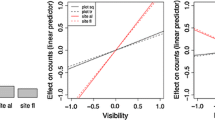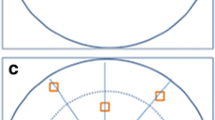Abstract
Prairie fens are globally vulnerable wetlands that are considered a conservation priority due to threats to their high biodiversity and hydrological functions. Establishing a thorough and repeatable plant sampling protocol is critical to evaluating conservation and management initiatives. Our goal was to evaluate a sample methodology designed to assess prairie fen plant diversity and determine if it produced results (1) representative of site diversity, (2) comparable among fens, and (3) efficient to collect. Nineteen fens between 8.5 and 28.4 ha were surveyed twice within one growing season during 2012 and 2013 field seasons using an area-proportional, random design. The turnover in species between spring and summer sampling periods within a site ranged from 8 to 50 %. Sample coverage of total estimated plant species richness ranged from 84.8 to 95.0 % with a mean of 90.1 %. We compared results from our area-proportional, random design to simulated random samples of 10, 15, 20, 25, 30, 35 and 40 quadrats per site. No significant difference was found in sample coverage per fen when using sampling rates of 25, 30, or 35 quadrats per site versus the area-proportional design. Shannon’s diversity index and floristic quality index differed by sample period and number of quadrats sampled per fen. Our sample design produced acceptable levels of coverage and facilitated comparisons across fens. Our methodology could be applied to future research, restoration monitoring, and conservation planning efforts in Midwestern prairie fens.




Similar content being viewed by others
References
Albert DA (1995) Regional landscape ecosystems of Michigan, Minnesota, and Wisconsin: a working map and classification. United States Department of Agriculture, Forest Service, North Central Forest Experiment Station. Jamestown, ND: Northern Prairie Wildlife Resarch Center Online
Alroy J (2010a) The shifting balance of diversity among major marine animal groups. Science 329:1191–1194
Alroy J (2010b) Geographical, environmental and intrinsic biotic controls on Phanerozoic marine diversification. Palaeontology 53:1211–1235
Amon JP, Thompson CA, Carpenter QJ, Miner J (2002) Temperate zone fens of the glaciated Midwestern USA. Wetlands 22:301–317
Bassett T (2004) Prairie fen preserved in an urban environment. Proceedings of the 19th North American Prairie Conference 139–148
Bedford BL, Godwin KS (2003) Fens of the United States: distribution, characteristics, and scientific connection versus legal isolation. Wetlands 23:608–629
Bourdaghs M (2012) Development of a rapid floristic quality assessment. wq-bwm2-02a. Minnesota Pollution Control Agency, St Paul, pp 1–56
Bourdaghs M, Johnston CA, Regal RR (2006) Properties and performance of the floristic quality index in Great Lakes coastal wetlands. Wetlands 26:718–735
Carpenter QJ (1995) Toward a new definition of calcareous fen for Wisconsin (USA). Dissertation, University of Wisconsin-Madison
Chao A, Jost L (2012) Coverage-based rarefaction and extrapolation: standardizing samples by completeness rather than size. Ecology 93:2533–2547
Charney N, Record S (2009) Package “vegetarian.” In: R Foundation for Statistical Computing. http://cran.uvigo.es/web/packages/vegetarian/vegetarian.pdf. Accessed 29 Oct 2012
Colwell RK, Coddington JA (1994) Estimating terrestrial biodiversity through extrapolation. Philos Trans R Soc B 345:101–118
Colwell RK, Mao CX, Chang J (2004) Interpolating, extrapolating, and comparing incidence-based species accumulation curves. Ecology 85:2717–2727
Colwell RK, Chao A, Gotelli NJ et al (2012) Models and estimators linking individual-based and sample-based rarefaction, extrapolation and comparison of assemblages. J Plant Ecol 5:3–21
Connor EF, McCoy ED (1979) The statistics and biology of the species-area relationship. Am Nat 113:791–833
Crancer CJ (2011) Restoration and vegetation response in Kirk Fen, a prairie fen in Ann Arbor, Michigan. Thesis, School of Natural Resources, University of Michigan
Daubenmire R (1959) A canopy-coverage method of vegetational analysis. Northwest Sci 33:43–64
Fiedler AK, Landis DA (2012) Biotic and abiotic conditions in Michigan prairie fen invaded by glossy buckthorn (Frangula alnus). Nat Area J 32:41–53
Francis CM, Austen M, Bowles JM, Draper WB (2000) Assessing floristic quality in southern Ontario woodlands. Nat Area J 20:66–77
Gotelli NJ, Colwell RK (2001) Quantifying biodiversity: procedures and pitfalls in the measurement and comparison of species richness. Ecol Lett 4:379–391. doi:10.1046/j.1461-0248.2001.00230.x
Gotelli NJ, Colwell RK (2011) Estimating species richness. In: Magurran AE, McGill BJ (eds) Biological diversity: frontiers in measurement and assessment. Oxford University Press, Oxford, pp 39–54
Herman DK, Masters LA, Penskar MR et al (2001) Floristic quality assessment with wetland categories and examples of computer application for the state of Michigan, 2nd edn. Michigan Department of Natural Resources Wildlife Edition, Lansing
Hill JL, Curran PJ, Foody GM (1994) The effect of sampling on the species-area curve. Glob Ecol Biogrogr Lett 4:97–106
Horn HS (1966) Measurement of “overlap” in comparative ecological studies. Am Nat 100:419–424
Hsieh TC, Ma KH, Chao A (2013) iNEXT online: interpolation and extrapolation (version 1.3.0) [software]. http://chao.stat.nthu.edu.tw/blog/software-download/. Accessed 20 Feb 2014
Jaccard P (1912) The distribution of flora in the alpine zone. New Phytol 11:37–50
Jenks GF (1967) The data model concept in statistical mapping. Int Yearb Cartogr 7:186–190
Johnston CA, Zedler JB, Tulbure MG et al (2009) A unifying approach for evaluating the condition of wetland plant communities and identifying related stressors. Ecol Appl 19:1739–1757
Jost L (2006) Entropy and diversity. Oikos 113:363–375
Jost L (2007) Partitioning diversity into independent alpha and beta components. Ecology 88:2427–2439
Jost L (2010) The relation between evenness and diversity. Divers 2:207–232
Kost MA, Hyde DA (2009) Exploring the prairie fen wetlands of Michigan. Michigan State University, East Lansing
Kost MA, Albert DA, Cohen JG et al (2007) Natural communities of Michigan: classification and description. pp 1–323
Lopez RD, Davis CB, Fennessy MS (2002) Ecological relationships between landscape change and plant guilds in depressional wetlands. Landsc Ecol 17:43–56
Matthews JW (2003) Assessment of the floristic quality index for use in Illinois, USA, wetlands. Nat Area J 23:53–60
Matthews JW, Tessene PA, Wiesbrook SM, Zercher BW (2005) Effect of area and isolation on species richness and indices of floristic quality in Illinois, USA wetlands. Wetlands 25:607–615
Michigan Natural Features Inventory (2011) Biotics 4—Michigan’s Natural Heritage Database. Lansing, Michigan. Accessed 14 Nov 2011
Minnesota Pollution Control Agency (MPCA) (2014) Rapid floristic quality assessment manual. wq-bwm2-02b. Minnesota Pollution Control Agency, St Paul, pp 1–44
Moran RC (1981) Prairie fens in northeastern Illinois: floristic composition and disturbance. In: Stuckey RL, Reese KJ (eds) Proceedings Sixth North American Prairie Conference. Columbus, OH, pp 164–168
Rasmussen SL, Starr N (1979) Optimal and adaptive stopping in the search for new species. J Am Stat Assoc 74:661
Reznicek AA, Voss EG, Walters BS (2011) Michigan Flora online. In: University of Michigan. Web. http://michiganflora.net. Accessed 16 Feb 2014
Ruiz-Jaén MC, Aide TM (2005) Restoration success: how is it being measured? Restor Ecol 13:569–577
Rydin H, Jeglum J (2006) The biology of peatlands. Oxford University Press, New York
Shannon C, Weaver W (1949) The mathematical theory of information. University of Illinois Press, Urbana
Sluis WJ (2002) Patterns of species richness and composition in re-created grassland. Restor Ecol 10:677–684
Sørensen T (1948) A method of establishing groups of equal amplitude in plant sociology based on similarity of species and its application to analyses of vegetation on Danish commons. Biol Skr Dan Vid Sel 5:1–34
Spieles JB, Comer PJ, Albert DA, Kost MA (1999) Natural community abstract for prairie fen. Michigan Natural Features Inventory, Lansing, Michigan
Swink F, Wilhelm GS (1994) Plants of the Chicago Region, 4th edn. Indiana Academy of Science, Indianapolis
Tilman D, Naeem S, Knops JMH et al (1997) Biodiversity and ecosystem properties. Science 278:1866–1867
Tilman D, Isbell F, Cowles JM (2014) Biodiversity and ecosystem functioning. Annu Rev Ecol Evol Syst 45:471–493. doi:10.1146/annurev-ecolsys-120213-091917
Tucker G, Fasham M, Hill D et al (2005) Planning a programme. In: Hill D, Fasham M, Tucker G et al (eds) Handbook of biodiversity methods: survey, evaluation and monitoring. Cambridge University Press, Cambridge, pp 6–64
Wilhelm GS, Masters LA (1995) Floristic quality assessment in the Chicago Region and application computer programs. Morton Arboretum, Lisle
Wolda H (1981) Similarity indices, sample size and diversity. Oecologia 50:296–302
Young TP (2000) Restoration ecology and conservation biology. Biol Conserv 92:73–83
Acknowledgments
The authors thank C. May and K. Pangle for their advice and expertise throughout the project and critical reading of the manuscript, and A.A. Reznicek for assistance in plant identification. We also thank all the private property owners, Jackson County, Livingston Land Conservancy, The Nature Conservancy, North Oakland Headwaters Land Conservancy, Oak Point Country Club, Servants of the Word, State of Michigan, and Washtenaw County for granting permission for research on their land. The authors also thank the editors and anonymous reviewers for their constructive comments on this manuscript. This work was supported by Botanical Society of America, Central Michigan University, Hanes Trust Foundation, Michigan Garden Club, Inc., and The Nature Conservancy. This paper is Contribution Number 70 of the Central Michigan University Institute for Great Lakes Research.
Author information
Authors and Affiliations
Corresponding author
Electronic supplementary material
Below is the link to the electronic supplementary material.
Rights and permissions
About this article
Cite this article
Hackett, R.A., Monfils, M.J. & Monfils, A.K. Evaluating a sampling protocol for assessing plant diversity in prairie fens. Wetlands Ecol Manage 24, 609–622 (2016). https://doi.org/10.1007/s11273-016-9491-1
Received:
Accepted:
Published:
Issue Date:
DOI: https://doi.org/10.1007/s11273-016-9491-1




